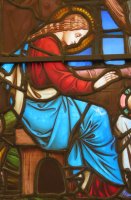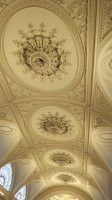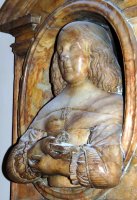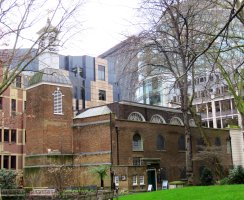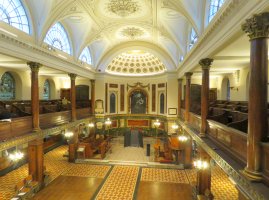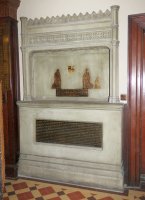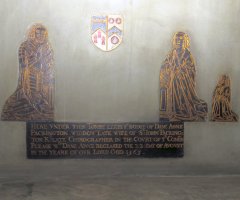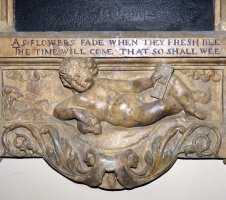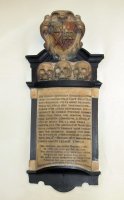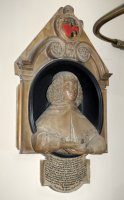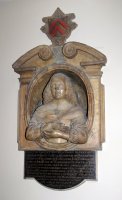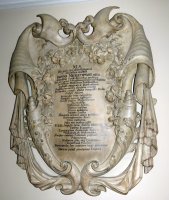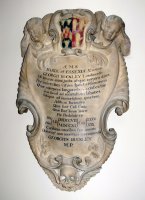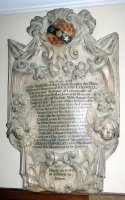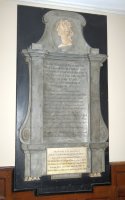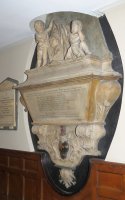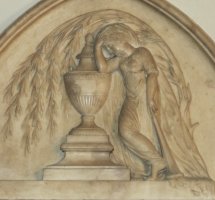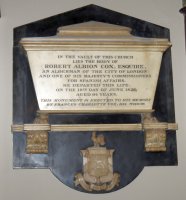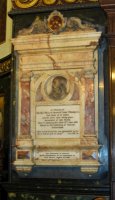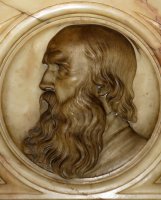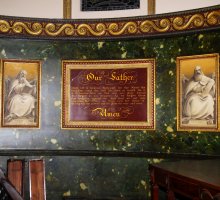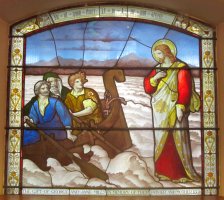St Botolph Aldersgate Church - Monuments in 10 Minutes
A 10-minute look at the monuments in the City of London Church of St Botolph Aldersgate. Inside is an elegant 1790s interior, and around two dozen monuments, including a great 16th Century altar tomb, 17th and 18th Century pieces from a previous church on the site, and later, simpler panels..
St Botolph Aldersgate, 1790-91.
This page is for visitors who have only a brief time to see the Church and its monuments. When you have more time for a longer visit, see this much fuller description of all the monuments.
St Botolph Aldersgate is in Postman’s Park, a brief stroll north of St Paul’s Cathedral. It was built in 1790-91, by architect Nathaniel Wright, and is of rectangular or Roman basilica design, built of brick with a small tower, dome and wooden spire, and a Palladian Classical frontage to Aldersgate dating from 1831. The decoration is all reserved for the inside, with rich wood and marble and beautiful vaulted and ribbed ceilings. Around half of the two dozen monuments are ones from the previous Church, the rest more recent. We take them in date order - click on the pictures to enlarge.
Altar tomb and brass to Dame Anne Packington, d.1563.
The oldest monument is a sideboard-like altar tomb, with a recess above containing brasses, to Dame Anne Packington, d.1563, seen with her husband Sir John Packington, a daughter, and a shield of arms. Such canopied altar tombs, of which this is a fairly late example, can also be seen in two other City of London Churches: St Helen’s Bishopsgate and in St Dunstan Stepney.
Christopher Tamworth's putto, and the Coston monument with skulls.
Next, see two tall wall panels. One, with the inscription now blacked out, is to Christopher Tamworth, d.1624, and wife Frances Tamworth, d.1637, and has a relaxing putto [plump cherublike infant] carved on the base, picture above left. Of similar date is the panel to John Coston, d.1614, his wife Frances [Blythe] Coston, d.1637, and daughter Ann Coston, d.1614. It includes three grim skulls at the top representing the three members of the family, and may be by the local sculptor Humphrey Moyer. Picture above right, click to enlarge.
Portrait busts: Eliz. Richardson, Eliz. Ashton.
Next we have two portrait busts, rather similar in pose, each within an oval niche. The earlier one is to Elizabeth [Hewytt] Richardson, d.1639, and shows her wearing a curious collar giving a triangular shape to her upper body: the sculptor is almost certainly the eccentric William Wright of Charing Cross. The second, to Elizabeth Ashton, d.1662, is more characterful, showing her with a slight smile, and holding a book.
Cartouche panels (click to enlarge).
The Church contains three cartouche monuments from the late 17th and early 18th Centuries - highly sculptural alternatives to the normal rectangular wall panels, with richly carved borders of scrolling, hanging drapery and flowers; two of them include winged cherub heads, and one a death's head, or bat-winged skull (central picture above, click to enlarge). See this page for lots more cherub heads, and this page for skulls.
Monuments to Elizabeth Smith, and Zachariah Foxall.
Now two must-see monuments. First, a tall, grey panel to Elizabeth Smith, d.1750, with a poem, beginning ‘Not far remote lies a lamented Fair, // Whom Heav’n had fashion’d with peculiar Care’, and ending sombrely ‘Learn from this Marble, what thou valu’st most, // And sett’st thy Heart upon, may soon be lost.’ It includes a portrait carved in high relief, notable for being a wor of the eminent sculptor Louis-Francois Roubiliac. Secondly, the largest wall monument, tall enough that a cut-out had to be left in the gallery above. It is to Zachariah Foxall, d.1758, whose portrait we see at the top of the monument, a drape held above it by a cherub, with a second cherub seated on the other side, on top of a great boxy casket protruding from the wall. A good example of the more grand, extravagant style of many monuments of around this period, by a sculptor called James Annis, who had his mason’s yard close by in Aldersgate Street itself.
Catherine Meade, d.1790: sculptor R. Cooke.
Next, to a monument made at the time the current church was built: Miss Cathe[rine] Mary Meade, d.1790, daughter of George Meade of Philadelphia, North America, with an inscription reading ‘Transferred from Pennsylvania’s friendly coast, // A Fathers Blessing and a Mothers boast; // On Albions Sea-girl Shore, an early fate, // Postponed each transport to a future State: // Death raised a barrier to each tender scene, // More fatal that the Waves that roll between.’ We see a scene with a monumental urn on a base, and leaning against it, a mourning girl, with a dying tree over all. By the sculptor R. Cooke, who also made a monument to the father, in Christ Church Philadelphia, USA.
White-on-black panels: Robert Cox, and Revd. Legh.
By 1800, most monuments became simpler white-on-black panels, with much reduced carving, and there are several of these in the Church. Here is just one example: the panel to Theodore Emanuel Cox, d.1805, cut as a casket, on little carved lion's feet, which is traditional, and signed by the fairly prolific stone-mason Whitelaw of New Road Fitzroy Square.
Coloured marble panel to Revd. Webber
And lastly of our monuments, one to The Revd. William Charles Fynes Webber, d.1881, showing a mid-Victorian fashion of going back to more coloured monuments. This one is one of two Victorian panels with relief portraits; the other is to Thomas Henry Ellis, d.1885.
Aside from our monuments, the Church has a variety of other interesting features, either from when it was built in 1790-91, or Victorian. Have a look at the stained glass, 18th Century, Victorian, and later; the oil paintings, most particularly the four Evangelists behind the altar table; the Font, round on a thick stem, in coloured marbles; and the woodwork.
Outside, Postman's Park, which combines the remnants of St Botolph churchyard and other land, contains the painter and sculptor G.F. Watts' memorial to Heroic Self Sacrifice, with ceramic tile plaques to those who died rescuing others.
And there our brief visit ends: if you want more, here is the longer page on the monuments.
The Church website is at https://www.stbotolphsaldersgate.org.uk/about-us/about-us/.
